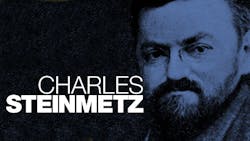Charles Proteus Steinmetz was both an electrical engineering genius and a great forward thinker in educational and social issues. In the scientific field, Steinmetz is remembered for many electrically related inventions. He invented a commercially successful alternating-current motor, identified and explained the Law of Hysteresis governing power losses, developed a user-friendly method to manage and calculate values for alternating current, and invented lightning-resistant high-power transmission lines. Due to his work in electrical engineering, the U.S. electric power industry experienced rapid expansion in the late 1800s and early twentieth century.
Many people know about these scientific successes, but his advanced cultural and socialist ideas, especially in education, are much less known. Nevertheless, Steinmetz's achievements in his adopted home in Schenectady, N.Y., did just as much to change peoples' lives. Steinmetz was deeply concerned with the state of Schenectady's education system, so he set about to reform it. He served on the school board for six years and headed it for four. During that time, he put the socialist beliefs that had forced him to earlier leave Germany and then Switzerland into action.
He had more schools built so students could attend a full day of classes instead of just half days. The system hired nurses and doctors. Undernourished students were fed in special rooms. Immigrant children with language problems had special ungraded classes. Learning disabled pupils received special help. And in another first for the area, all primary grade textbooks were free.
On the political front, Steinmetz promoted a united Europe while World War I was raging there. He also wrote against racism in the United States. One of his ideas, though, has yet to grab a following: the four-hour day promoted in his book America and the New Time.
Back in the science field, those electrically powered cars that today's engineers are struggling to develop were one of his last engineering concepts. In 1920, he formed the Steinmetz Electric Motor Car Co. and designed several prototypes. A year before his Oct. 26, 1923 death, he produced a lightweight electrical truck. To publicize the event, the truck climbed a steep Brooklyn hill in 1922. Imagine the cultural and economic change if he'd been able to continue his work in this field!
The hatmaker mentors Steinmetz
Steinmetz emigrated to the U.S. in July 1889 from Switzerland, where he had fled after his socialist ideas failed to be popular with the local German police. Shortly after his arrival in the U.S., he met another German immigrant, Rudolph Eickemeyer, inventor of hat-making machinery.
Under Eickemeyer's tutelage and mentoring at his Yonkers, N.Y., factory, Steinmetz explored the different aspects of electrical engineering and uncovered the law governing hysteresis. Also during this time, he changed his birth name from Karl August Rudolf to Charles Proteus, the latter being a university nickname based on the Greek god who took on any shape.
General Electric founder Thomas Edison soon recognized Steinmetz's genius and tried to hire him. But the engineer declined the offer, choosing to stay loyal to his mentor. So Edison, who also wanted the patents Eickemeyer's company held, bought the entire business along with Steinmetz.
Among his first assignments at GE was the design of generators for the new Niagara Falls power-generating station. As head of the calculating department, he indoctrinated engineers with his alternating-current calculation method. He wrote many papers and books explaining in simplified terms the theory of alternating current.
Steinmetz also enjoyed working in his scientific laboratory, which GE built next to his Schenectady home on Wendell Avenue. There, he studied the chemistry of electrical insulating materials and arc lights. It led to his invention of the metallic electrode arc lamp and the subsequent lighting of cities across the country.
Law explaining power losses
Steinmetz first explained the Law of Hysteresis in The Electrical Engineer magazine on Dec. 8, 1891 and later in a speech to the American Institute of Electrical Engineers in New York City on Jan. 19, 1892. He was just 27. The law let engineers know before building an electrically powered machine just how much power loss would occur due to magnetism. Those who understood it hailed it.
Steinmetz's second major feat, developing a user-friendly method to manage and calculate values for alternating current, also let engineers determine an outcome before building a machine or designing power lines. Instead of building a system and then determining its efficiency, engineers could use mathematics to predict a system's performance. The average engineer could work with alternating current and cut expenses.
Steinmetz presented this method to the International Electrical Congress in 1893, but few understood it. He explained it in his book Theory and Calculation of Alternating Current Phenomena (co-authored by Ernest J. Berg, 1897), but still few understood it. Steinmetz realized most engineers didn't know enough mathematics to understand this method, so he set about to change that.
When asked in 1903 to help Union College in Schenectady, he developed a new electrical engineering curriculum and became its Professor of Electrical Engineering and Applied Physics. Also, he headed the School of Electrical Engineering until 1913, making it among the nation's best. He taught until 1923 without accepting any pay. And, he wrote several textbooks, including Engineering Mathematics (1911), to give engineers the math they need to simplify their work.
